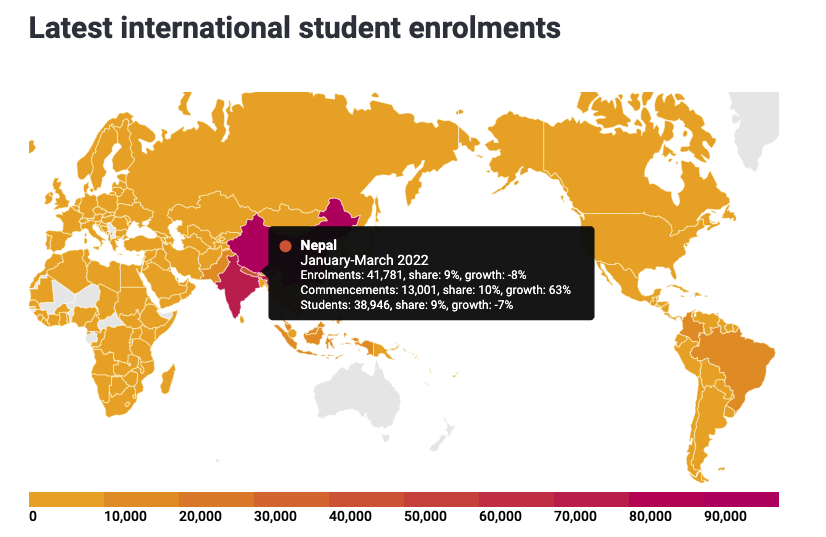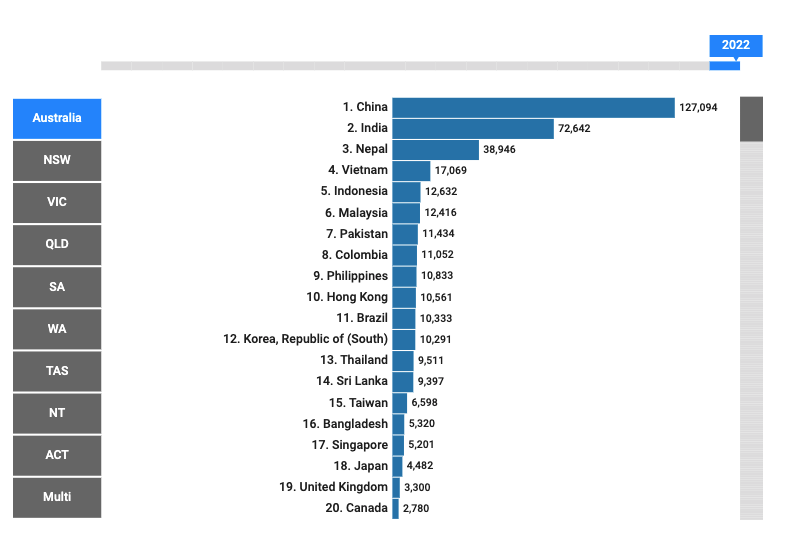Every year thousands of Nepalese students fly to Australia from Nepal for higher studies. Based on a recent report by the Department of skills employment and Education, more than 41,000 students enrolled in Australian education institutes from Nepal.
The number of students studying in Australia between Jan-March 2022 is self-explanatory of the popularity of the Australian education system among Nepalese students.

Similarly, in 2022, Nepal stands third in terms of international students studying in Australia, after China and India.

Australia is known for its excellence in educational institutions. Australian universities and colleges are practical and career-oriented.
Australia offers a wide variety of programs for students from all over the world, with more than 1,200 educational institutions and over 22,000 courses available. However, there is no formal ranking of universities, so you can’t compare them.
No matter what a student is studying or how long they are studying for, Australia’s laws promote quality education and protection for international students.
Universities and colleges in Australia offer facilities for teaching, training, and research to be on par with the rest of the world. As a result, they prepare graduates with the skills businesses require to help them compete in the global workplace.
Universities in Australia require students to have a CRICOS code given by the Australian government as proof of the student’s qualification and ensure the quality of education.
 There are three-tiered levels of education in Australia, where the university is the highest level of education in Australia.
There are three-tiered levels of education in Australia, where the university is the highest level of education in Australia.
University students can attend on-campus bachelor’s degrees or postgraduate courses (including certificate, postgraduate diploma, master and doctoral programs).
But Australia is also home to vocational education and training courses that offer everyone plenty of choices and opportunities.
Vocational training courses are available at government-funded institutions, including TAFE (Technical and Further Education) and private institutions. VET courses focus on practical skills and industry training.
For admissions into Australian education institutions there are two main requirements to fulfil. The first is Academic requirement, as well as English language requirement.
Admissions requirements vary from program to program and university to university in Australia.
If a university or college offers a particular course, it is usually up to the university or college to decide which specific qualifications they require for an applicant to be eligible to enrol in that course.
 VET courses in Australia
VET courses in AustraliaEvery year hundreds of students from Nepal apply for Australian student visa. Not all pass through the set of standard rules set by the Australian Immigration Authority to acquire student visa.
Although Australian Student Visa rules are stricter but with proper guidance and well-documented papers students are successful to receive student visa.
The process involves filling out an application form, paying the required fees, submitting supporting documents and getting your application approved by a panel of immigration officers.
Student tuition fees are one of the highest costs that have to be borne by students aspiring to study in Australia.
Tuition fees can vary from university to university, degree program to degree program, and based on the type of degree.
However, before you leave for Australia, be sure to consider any costs associated with staying there, including accommodation, food, health insurance, and travel. It will help you plan your budget more effectively.
Here’s what the estimated bank balance required for an Australian student visa from Nepal is:
It’s essential to understand the living cost and expenses in Australia.
Source: https://www.studyaustralia.gov.au/english/live/living-costs